Working on the Crewel Rooster project, I’ve had the opportunity to play around with seven different crewel wools currently on the market. Today, I want to show you those threads up close – just the threads. In looking at just the threads, though, out of context, I will admit there’s not a lot to learn from them. You might get an idea of their structure, but other than that, you can’t tell much from them unless you see them in context, in stitching. That’s the way I see it, anyway!
So my plan – and I’m slowly working on it – is to show you some stitch samples with each of these threads, and to put the samples side-by-side so that you can see them and compare the outcome of the stitching with the various threads. In the meantime, though, let’s look at the seven different threads I’ve been working with.
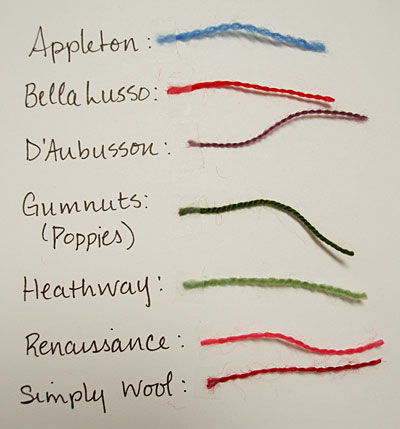
These are the threads I used, in alphabetical order: Appleton crewel (100% wool from England), Bella Lusso (100% merino wool from Italy), D’Aubusson (100% wool from France), Gumnuts Poppies (a 50/50 silk/wool blend, from Australia), Heathway (100% merino wool from Wales), Renaissance Dyeing crewel wool (100% merino wool, vegetable dyed, from France, but the wool is from England), and Simply Wool by Gentle Art (100% wool – company is located in the US, but I don’t know where the wool is from).
With the exception of Gumnut Poppies (which is a wool / silk blend), all the threads are wool, and you’d think they’d all pretty much be the same, since they’re all wool, but they aren’t. And even though several of them look the same, they stitch differently.
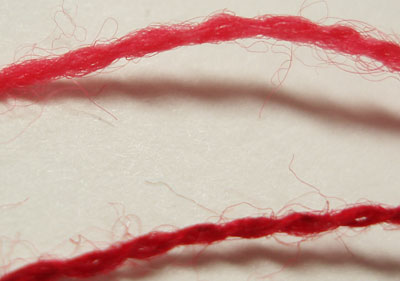
Simple Wool (lower) and Renaissance wool (top): fine, two-ply wool, kind of hairy. These two look a lot alike – they feel completely different when you stitch with them!
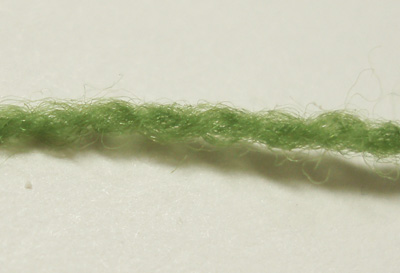
Heathway is a two-ply merino wool, but the plies twist around each other with a closer twist – not a tighter twist than the others, because the thread isn’t tightly twisted. But the “spring” shape of the twist is definitely closer. This makes the thread a bit stretchier and springier. It also makes it very smooth when stretched out in stitching.
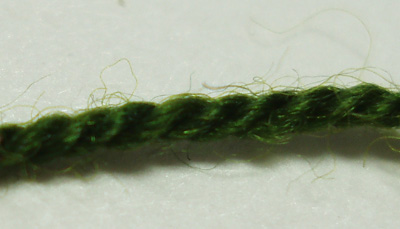
Gumnut Poppies: The presence of silk, I think, is obvious. The strands look smoother, more lustrous, and they hold together in their twist, thick and soft.
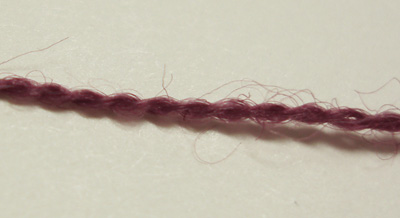
D’Aubusson’s twist is a bit shorter – it looks like Simply Wool, which has a slightly shorter twist than the Renaissance wool. But the twist is much longer than Heathway’s.
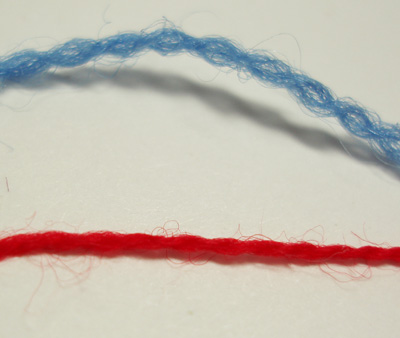
Bella Lusso (lower) was difficult to photograph (red threads are always difficult to photograph, for some reason!), but you can see that its twist holds together more than the other threads – it is softer, and the fibers are longer. It reminds me more of a cotton-floche-gone-hairy than of wool. And Appleton (top) is again a two-ply twist, but notice how the plies are really separated from each other? They are long twists, but very loose, and the fibers in Appleton wool are also kind of loose and all over the place.
So, although the threads (except Poppies) are all wool, and though they look alike at a glance, they have subtle differences, and these differences come across in the way they stitch. What makes them different? The way the wool is processed, the way it’s combed and spun, even the dye process, I suppose. You can read quite a bit, actually, on wool threads in general on the Renaissance Dyeing website. It’s a nice site with interesting information for those interested in wool threads, thread dyeing, vegetable dyes, and so forth.
I’ll be finishing up some stitch samples to show you how these threads perform. So stay tuned for that! In the meantime, I’m planning on getting the rooster finished over the next few days! Wish me luck!







Hi Mary,
This is a great idea. But how about including Paternayan wool? Do you have a sample? I can send you some if you like.
Hi Mary, I've been looking for a fine weight wool to sell for canvas work so I found your comparison very useful, thank you! I was curious why with including Gumnut in your studies if there was a reason/s why their Blossoms or Daisies, both being 100% wool with a color range of 165 colors, were not considered. I did enjoy greatly reading about Renaissance Dyeing and am looking forward to a little further investigation. Sincerely, Karen
Thanks for the description of the different wool available. This was a post that answered all the questions I have meaning to ask you about the ply and the textures of different wool. Your rooster project has been a great learning experience and I am waiting to see the finished piece.
As a knitter, my first thought was "Of course all wool's not the same, what's she on about?" Then I remembered that non-knitters don't usually care nearly so much about sheep breeds and so on.
G'day Mary,
Thanks for the valuable info on these threads.
Yes, good luck strutting your stuff to finish 'our' rooster.
Trust you feel ok now.
Cheers, Kath.
Thanks for your comments, all!
I have a wool thread that I think might be Paternayan crewel weight, but I'm not sure if it is. So I didn't want to include it, and be wrong about that! Thanks, Cynthia!
Concerning including the poppies, I included the wools (well, and a blend) that I used on the rooster. I would have been happy to include the other Gumnut yarns that are 100% wool, but I don't have any in my stash. I tried to contact Gumnut for samples, but they sent me to their US distributor, who, for some reason, I can't seem to get through to. So right now, I'm limited to the threads in my stash, unless I invest in some other wools, which I may do in the future.
Yes, I think knitters are much more aware of the different breeds of sheep and the wool they produce. This is something I'd also like to learn a bit more about, so I've been reading up on it a bit, but don't know too much about it off the top of my head. It's obvious, though, as I read about it and work with the wools, that the wool and the process of combing, spinning, dyeing, and all that stuff have a direct influence on how well the embroidery wools work and feel, too. It's a subject I'll have to delve more deeply into in the future.
Thanks again for the comments, everyone!
MC
Thank you, Mary, for doing this. I'm looking forward to the stitched samples and commentary.
I agree with Cynthia that, if you can, including Paternayan would be good since it's so ubiquitous.
Hi Mary,
What is your top pick for wool thread? There is so much out there to choose from I figure I’ll start with your number one choice! Also, where do you buy your favorite wool thread?
Many thanks,
Terry
Hi, Terry –
It depends on the type of embroidery and the look I want. I like the Fine D’Aubusson for fine, detailed wool embroidery that requires a sharp, precise line. It’s a tighter wool. For filling and a softer look, I like Renaissance Dyeing wool. Both of them are available at Hedgehog Handworks!
Hope that helps!
MC
Hi,
we were doing some research on crewel embroidery wool thread and found your site very informative! We like that you are conscious of where the fiber comes from because we are a wool mill in Wyoming. We are just entering the crewel thread market and are looking at what the common packaging (ie. yardage and weight) looks like for the consumers. Would you recommend any changes to what appears to be the standard 28 yards? Thank you!
Hi Mary
I have in my stash 8 skeins of DMC pure wool, I think I picked them up quite a long time ago when my 3 girls were having babies and I was into embroidering baby blankets,(something like 24 years ago!) I felt, back then, that wool was more forgiving and didnt show my imperfections as much!
Do DMC still do the embroidery wool do you know?
I still consider myself very much a learner with surface embroidery using cottons etc and thoroughly enjoy your daily teachings I have learned so much from from them and your site.
Thankyou Mary,
Trish
Hi, Trish – Yes, if it’s DMC Medicis, you can still buy it. They stopped producing it for a while, or at least importing it here. I don’t know if it’s actually called DMC Medicis anymore, or if it’s produced by DMC, but here’s some information on it: http://www.threadneedlestreet.com/Medicis.html
DMC also produces a tapestry wool for needlepoint. It’s not crewel weight wool (so it wouldn’t be used for surface embroidery). You can read about that here, and see it close up:
http://www.dmc-usa.com/Products/Needlework-Threads/Needlepoint-Threads/Tapestry-Wool.aspx?technique=needlepoint
Hi Mary,
I have a bit of allergy to wool clothing and I am wondering if the thread would make me itch… I am SO wanting to try a small project. Maybe I will just buy a bit of wool thread and try it out!
Thanks for your lovely site.
Pam
am desperate to find shop which sells 2 ply Appleton embroidery wool in Victoria Australia. can you help?
Hi, Not sure if this is what you are looking for, but Create in Stitch http://www.createinstitch.com.au/shop/wool-threads/appletons-crewel-wool/
has these ones for $2.50 each and they’re in Highgate, SA.
All Threads in Brisbane also have Appletons though I can’t tell if they are 2ply http://www.allthreads.com.au/appletons-3
Morris & Sons also stock Appleton Tapestry Wool http://morrisandsons.com.au/c25_695_554/ as well as crewel wool http://morrisandsons.com.au/c25_875_555/
and they’re in Sydney.
There’s also Mt. Eliza Needlework in Victoria, & according to their website they stock the complete range of Appletons 2 ply wool and tapestry wool http://mtelizaneedlework.com.au/products/
Victoria House Needlecraft in Mittagong also stocks them and they are currently on special for $2 each http://www.victoriahouseneedlecraft.com.au/blog/products-page/threads/appletons-crewel-wool-skeins/
Hope these are of some help to you.
SOOOO nice! Im trying to spin my own wool, since I can´t buy it at home. Your information and photos are SO helpful!!!!
Thanks
Hi Mary,
I enjoyed reading your post about the different crewel threads ( https://needlenthread.wpengine.com/2010/01/comparison-of-wool-threads-for-crewel.html). I’ve tried to find the follow up threads to this original one and have not had any success. Are you able to send me the link to part 2?
Thanks
Kate
Hi, Kate – the follow up on that was pretty much the whole Crewel Rooster project, where I used different types of crewel threads on the whole project, testing them out and seeing how they stitched. Hope that helps!
This may be a silly question, but can you use any wool for crewel work? I impulsively bought a lot of Anchor Tapestry wool which is the same company as Coats. It’s decent quality and wondering if I can use it for Crewel work embroidery?
Hi
Do you know where I can obtain a conversion chart for Gumnuts to Appletons? I want to embroider a crewel wool bolster using a pattern from Inspirations but the cost of Gumnuts is way beyond my price range!
Many thanks.
Regards
Kate
I am curious about wool sold as tapestry. DMC Floralia Tapestry wool, is sold as 3 ply and divisible but then I read that is isn’t. I buy a lot of thread lots and yarn off Ebay because I can’t afford to buy it all from online stores and I don’t have a store near me that even sells embroidery embroidery supplies.
I have purchased a lot of Medicis and have found a source for it new. What I love about embroidery is that I don’t need to follow a color chart like I do with cross stitch.
I guess I would like to know about some of these other threads offered on Ebay. Can they be used for crewel? Why are some labeled needlepoint and other tapestry. I thought they were the same thing. What about Paternayan Persian yarns can these be separated and used for crewel?
Now I will do some more research on the threads you have listed. I did buy the Renaissance Dyeing selection you featured at Christmas. Gumnuts is out of my price range except for a few special projects. So other than Appleton I haven’t heard of the others you have listed.
Hi, Oriole – Just keep in mind that yarns that are spun for knitting are not the same as wool threads spun for embroidery. It all really depends on the type of ground fabric you’re using, how much friction will be on the thread or yarn, and so forth. I don’t know what to tell you about the yarns you find on eBay, because I can’t see them. I think Paternayan wool can be divided into three strands for crewel embroidery. Well, the old Paternayan could. I’m pretty sure it’s the case with the newer Paternayan out now.
Hello
Firstly thank you for your inspiring posts.
I found the post dated 27 January 2010 concerning crewel work threads very helpful. I have been trying to find Part 2 as I am very interested in your thoughts on how the different threads perform. Unfortunately I can’t find Part 2. Could you please let me know the title of Part 2 so I can locate it.
Many thanks and best wishes
Del
Just wanted to say thank you for the overview comparing some of the types of wool. It is very much appreciated! Thank you again so much!
Hi
I am starting my first crewel project (a Sunset Stitchery Kit). The directions say to separate the 2-ply thread into 2 1-ply threads. But it disintegrates when I try to separate the strands. What am I doing wrong?
Thanks for helping me out.
Hi, Kathleen – if possible, it might be better to contact whoever produced the kit and ask what the deal is with the thread falling apart on you. It could be that they’re not using a quality thread in the kit, or maybe they mean something else by their instructions (though it sounds pretty clear to me what they want you to do). Crewel thread is a two-ply thread structure, usually, so you’re going to lose some strength in the thread when you separate plies, but it shouldn’t thread, and if the kit calls for that separation, then the thread should be able to hold up to it. I’d definitely contact the manufacturer of the kit!
Mary,
Really enjoyed your article on the different wool yarns! Wish I had stumbled on it long ago! Very helpful, but it prompts a couple questions: It appears that you focus on embroidery, but I hope you can answer these needlepoint questions.
I have been handed a project (started by another docent) for our local museum. Because it is for a museum I must be as accurate as possible. This is a covering for a late 19c. footstool. The design was previously chosen after considerable research – to be created based on attached 1840’s Wittish pattern.
My questions:
1. Canvas (18mesh) was handed to me with a just enough stitching done to create one line of the inner “check”” outline – but yarns so carefully tucked and clipped that I cannot tell what yarn it is. Paperwork from her would suggest it to be “Applen 2-ply”. Local stores do not stock the Appleton in anything but tapestry, which sample stitching proves is too heavy – therefore I was planning on their 2ply (Crewel). As I read I have seen stated that “2 strands will cover on 18 mesh canvas” – does this mean 2 strands of 2ply yarn (hence 4plies if one were to separate”) – or are they using strand and ply interchangably? Long way to ask: Do I need to double the 2ply Appleton yarn to get full coverage on 18 mesh canvas?
2. I was planning on using Appleton crewel until I read your article – until I read your article. Some of the research I was handed states, “Four-ply woolen merino (as opposed to two-ply worsted wools) were typically employed”. (A) Would the Bella Lusso be a better option? (B) If so, do their colors compare well to Appletons, which the museum has already approved? (C) Would it need to be doubled for the 18mesh canvas?
3. Whichever I use, do you stock/sell them?
Appreciate your help,
Kay Rath
I have used Waverly wool from Brown Sheep Company in Mitchell NE for doing a buffalo in 18 count canvas. Other threads were used for the rest of the design. I have also used Waverly on 13 count canvas and it covers well. One strand. It might be too bulky for all over because it covers with 13-14 count. I have asked Mary Corbet if she has tried it on crewel embroidery. It was an interesting article!
I haven’t used Waverly wool – I’m not familiar with it. I will have to look it up! I’m always happy to hear about new-to-me threads. Thanks, Lois!
Did you ever do the samples and decide which brand you prefer? I’m new to wool threads. I love your website. Thanks
You didn’t mention Waverly wool from Brown Sheep company in Mitchell Nebraska. Perhaps it is too heavy for crewel. I have used it on 18 count canvas and it is heavier than crewel wool. I haven’t stitched crewel embroidery in many years. I have used it on 13 count canvas too for church kneelers. I like that it has several hundred colors and is American made.
Nope, I haven’t heard of it. I will look them up!
I don’t see a part two for this one in the site search, and it’s a pretty old article by now. Did you post it under a different title? I’ve just done my first major project in wool, using Appleton. I didn’t love the experience, at all, as I found the threads to be pretty inconsistent in thickness in some places, and almost slubby here and there even before running it through fabric. We used large needles which made it work, but I want to know more about the other options out there. After this project I feel like crewel embroidery is not for me, but I suspect the tactile experience of the Appleton wool may be a large part of that feeling.
I’d love to see more information, and samples, of these crewel wools in action and hear an opinion about the pros an cons of the different brands available!
Do you have a suggestion for an equivalent replacement for Gumnuts in the US? I find them to be too expensive.
Are you aware of a conversion chart that would help purchase the correct Gumnut color in another brand?
Hi, Kim, Yes, they are a bit pricy! I don’t think you’ll find a conversion chart for other brands of threads. These smaller companies hand dye their threads. Gumnuts in particular are subtly shaded, as they are overdyed. So they’re not solid colors. It would be very difficult to come up with any accurate color conversion, even if you could find a thread that is compatible in weight, twist, and fiber content.
Your best bet if you want to go with a different brand is simply to color match using photos of the finished piece you want to stitch and getting as close as you can to what you perceive the colors to be in the photo you’re looking at. You might not come up with a precisely similar color scheme, but you should be able to come up with something that at least works and that you find pleasing.